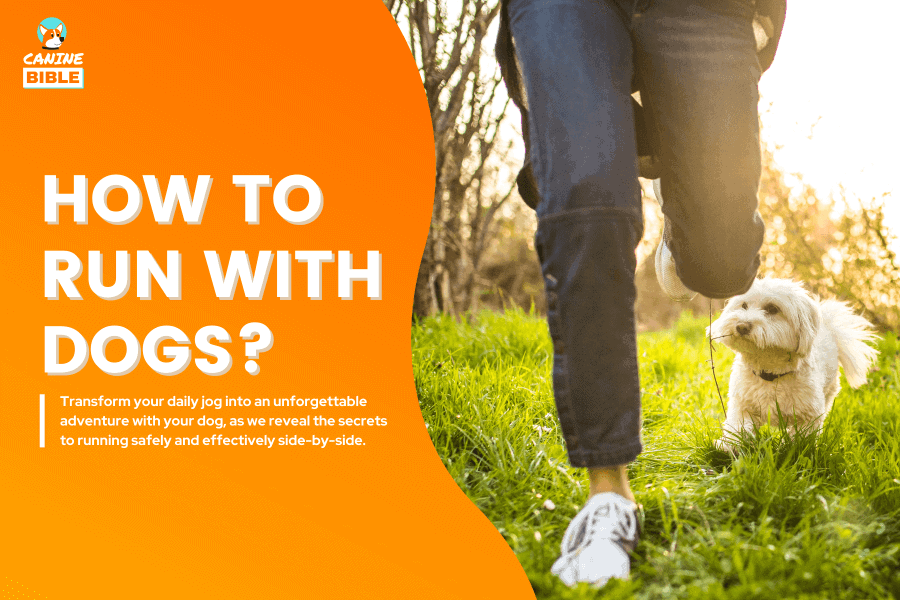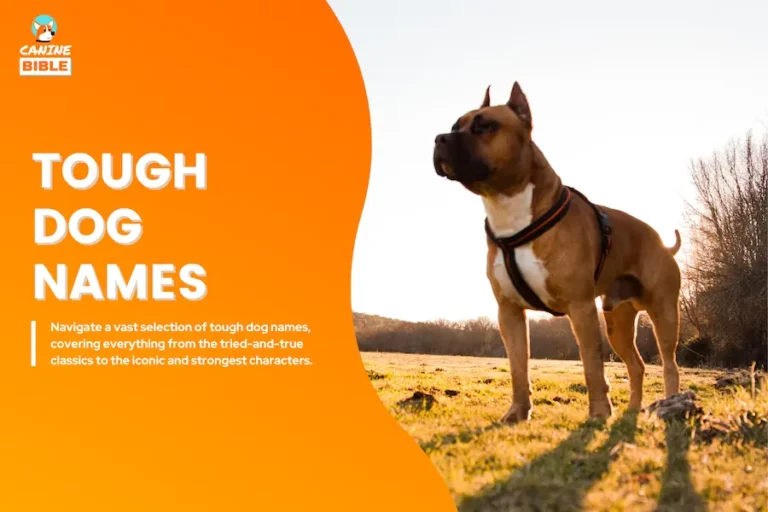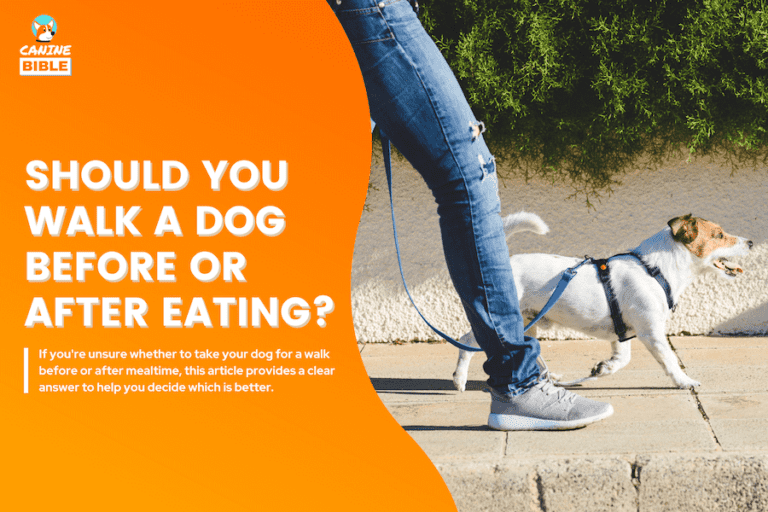Running With Dogs 101: How To Run With Your Dogs (Training Tips)

Canine Bible is reader-supported. We receive affiliate commissions via some of our links. This doesn’t affect rankings. Learn more.
This is the ultimate resource for anyone interested in taking their canine companion along for a run. As a responsible dog owner, it is crucial to understand the fundamentals of this activity to ensure the safety and well-being of your dog.
From understanding the proper running age to training tips on how to run with dogs, we’ve got it all covered. Discover expert tips on proper warm-ups and ways to motivate your pup during those long runs. Not only will you be improving your fitness, but you’ll also be providing your four-legged friend with the mental and physical stimulation they crave. Let’s get started!

When Can My Dog Start to Run?
Starting to run with your dog depends on three critical factors.
1. Bone Development (Growth Plates)
Running on hard surfaces like pavements can harm a young dog’s joints and bones, which may not have fully formed yet. According to Sharon Wirant, an animal behaviorist at the ASPCA, it is essential to wait until a young dog’s growth plates have started to close before engaging in rigorous exercise.
Growth plates in puppies refer to areas of cartilage tissue located near the ends of their long bones. These growth plates gradually calcify as the puppy grows and transform into solid bone.[1] Subjecting a young dog to strenuous exercise before their growth plates are fully developed can increase the risk of injury and potential fractures.
2. Age
It is recommended to avoid strenuous running with your puppy until their growth plates are fully mature. This typically occurs between the ages of 4 to 8 months but can vary depending on the dog breed.
To determine the usual closure times of growth plates in dogs, refer to the table below. Heather Loenser, Senior Veterinary Officer at the American Animal Hospital Association, suggests limiting runs to less than a mile before the nine-month mark.
| Dog Size | Dog Breeds | Weight Range (kg) | Rapid Growth Period | Timescale to Fully Size |
|---|---|---|---|---|
| Toy | Chihuahua, Pomeranian, Maltese, Toy Poodle | < 5 | Birth–11 weeks | 6 – 12 months |
| Small | Jack Russell Terrier, Dachshund, Pug, Miniature Schnauzer | 5 – 10 | Birth–14 weeks | 8 – 12 months |
| Medium | Border Collie, Cocker Spaniel, Beagle | 10 – 25 | Birth–16 weeks | 8 – 18 months |
| Large | German Shepherd, Labrador Retriever, Golden Retriever, Bulldog, Boxer, Siberian Husky | 25 – 40 | Birth–18 weeks | 11 – 18 months |
| Giant | Great Dane, Mastiff | > 40 | Birth–20 weeks | 12 – 24 months |
3. Size
Large dog breeds generally take longer to mature growth plates than medium and small dog breeds fully. For instance, a Beagle may be able to start going on regular runs earlier than a larger dog breed, such as a German Shepherd. However, it is essential to note that the growth plates may not fully mature for some large and giant dog breeds until 18 to 20 months old.
To ensure your dog’s safety when starting to run, it is recommended to consult your veterinarian. They may take X-rays to determine if the bones have finished growing and if engaging in physical activity is safe.
How Many Miles Can a Dog Run?
Don’t expect your four-legged friend to be able to run marathon-length distances from the get-go. Your dog needs time to build its strength and endurance.
Nike+ Run Club’s Coach, Chris Bennett, tells us that the first run is about the dog, not you. Running with your dog is not supposed to be all running. Let them explore and have a good time as well. Your first several runs should not involve much running at all. Let your pup set the pace to make it an enjoyable experience your dog would want to have again.[2]
Conversely, if you are a professional, hardcore runner or are training for a marathon, you can have your dog join you on easy days. Some dogs can run up to 25 to 35 miles with the proper training and conditioning, The Whole Dog Journal reports.
How To You Run With Your Dog: 16 Must-Follow Tips
Here are the best tips for running with your dog that you need to follow.
Training Your Dog to Run With You: Step By Step
Shelby Semel, a professional dog trainer, suggests that if your dog is prone to dodge off course or easily excitable, it will need training before they’re ready to run. Use the following tips to teach your dog to run with you.
Step 1. Introduce Your Dog to The Harness (or backpack) And Hands-Free Leash.
Start by letting him get used to wearing both items. Then, let him wear them around the house and reward him with treats so he associates his new gear with an enjoyable experience.
Step 2. Teach Your Dog These Basic Commands Before Running
The American Kennel Club (AKC) suggests two essential commands your dog should master, the “let’s go” (or “get running”) cue and the “slow down” signal. You should alert your dog to the change in pace by using those verbal cues to let them know when it’s time to slow down or pick up the pace so that you’re not just jerking him on the leash.
Other vital commands Fido needs to understand are:
Step 3. Take Dog Outside For A Practice Run
Fill your pocket with dog running training treats and decide the side your dog will run. Hold treats in your right hand if your dog wants to run on the right side. Don’t forget your poop bag. Let’s respect the environment and other runners.
Step 4. Start Running & Gradually Increase The Distance (Maintain The “Heel” Position)
Take a quick jog for about 10 yards, then stop. Feed the dog some treats from your hand. It’s okay if the dog doesn’t stay in the “heel” position at first but always correct your dog if he doesn’t. Gradually increase the distance and reward every time you stop. This will teach your dog to run by your side; after a few weeks of practice, you won’t need treats.
NOTE: Minimize giving treats to your dog while running; it can cause an upset stomach and other problems in dogs.
Step 5. Stop Immediately If Your Dog Starts to Pull You or Runs Ahead
If the dog pulls ahead, stop running immediately. Use the “recall command” or “slow down” cute to call your dog back to you or slow him down. Lure him back with treats, but don’t treat him yet. Instead, do a quick job again before feeding.
Step 6. Repeat Steps Until Dog Masters Running Alongside You
When your dog is well-training for runs, you and your new running buddy can start working on building endurance and going on longer runs. Plan your route and a running schedule. Be consistent.
Benefits of Running With Your Dog
Runners often experience a sensation of euphoria commonly known as the “runner’s high.” This feeling is caused by higher levels of endocannabinoids in the brain, as explained by science. Research published in the Journal of Experimental Biology suggests that dogs also experience a similar “runner’s high” when they exercise.[4]
The benefits of the runner’s high include an improved mood, decreased anxiety, and reduced stress levels. This feeling of euphoria can also lead to increased self-esteem and confidence. Moreover, the release of endorphins during exercise can help to reduce pain and promote feelings of well-being. The runner’s high can also improve cognitive function and overall physical performance.
Running with your dog is beneficial not only physically but cognitively. Other expected benefits include:
Benefits For Humans
Dogs are runners by nature, providing more than just faithful companionship during runs. According to a study by the University of Michigan, people who go jogging or walk with their dogs are 34% more likely to abandon a sedentary lifestyle and practice more than 150 minutes of physical activity a week than people with other animals or none.[5]
Running with a dog by your side can be enjoyable and safer, particularly in dim or dark environments. It can also help to keep your dog healthy and in good shape, potentially reducing veterinary bills. Moreover, running with your dog can strengthen your relationship with them. Dogs can be the perfect running partners, exhibiting patience and encouraging you to push harder and maintain a consistent pace. They can motivate you to achieve your fitness goals and provide companionship.
Nutrition For Dogs That Run
Usually, you wouldn’t have to adjust your dog’s diet if you’re taking your dog out for a run a couple of times a week.
Dr. Joseph Wakshlag, a professor of clinical nutrition and sports medicine at Cornell University College of Veterinary Medicine, told The New York Times:
“For dogs jogging along with you for 20 minutes a few times a week, a normal commercial dog food containing about 15 or 16 percent fat should be fine. But if you and your dog run five or 10 miles a day, that dog likely needs a slightly higher-fat diet”.[6]
Dr. Joseph Wakshlag
Protein content should be at least 25 percent protein, preferably from meat. Dr. Joseph also mentions that if your canine friend runs continuously for more than 30 minutes, you should adjust the dog’s diet in terms of performance. You can use a service like The Farmer’s Dog, which is tailored your dog’s meals based on their activity levels.
Monitoring their weight regularly is essential to ensure that your dog’s nutritional requirements are met. If your dog is losing weight and seems hungrier, you may need to increase its food rations accordingly. Conversely, if your dog is gaining weight, you may need to adjust its diet and exercise regimen. It’s important to remember that water is the most critical nutrient for your dog. Providing water before, during, and after a run prevents dehydration. However, offering water in small amounts is crucial to avoid overhydration, which can lead to gastric volvulus and dilation (GDV), commonly referred to as “bloat.”
Running With Small Dogs
Is running good for small dogs? While most dogs love to run, there are a few caveats and dangers about running with small dogs.
Toy dog breeds (i.e., Chihuahua) are usually not great running partners. They may look energetic and healthy, but their frail bodies and small bone structure are not made for long runs. An American Society of Veterinary Journalists member, Dr. Sarah Wooten, says they might be up for a walk or quick jog but not a full-on run.
Running With Brachycephalic Dogs
If your dog is a brachycephalic breed, such as pugs, or a chondrodystrophic breed with shortened or bowed limbs, such as Bulldogs or Corgis, it is recommended to stick to walks or short, easy jogs. These breeds may have difficulty breathing and running due to the shape of their face or legs. Engaging in strenuous exercise can exacerbate these issues and potentially lead to respiratory problems, overheating, or joint pain.
Running With a Dog That Pulls
Teaching a dog not to pull during runs requires proper leash training.
If your dog starts pulling, it’s important to stop immediately. Grab the leash, stand still, and refuse to move until your dog calms down and returns to you. You can also try to redirect their attention with a treat as soon as you notice them starting to pull, but the most effective solution is to use leash training to address this behavior. If your dog tends to pull frequently during runs, they may benefit from using a harness and head halter to provide more control and prevent injury. It is recommended to consult with a professional dog trainer to determine the best training approach for your dog.
In this video, you will learn how to prevent your dog from pulling on its leash and train them to walk or run alongside you.

Dog Running Endurance Tips
The first advice to build endurance running is to start slowly and gradually increase the pace to achieve longer runs.
Here are five steps to building your dog’s endurance for longer runs.
Monitoring Your Dog During The Run
Understanding your dog’s capabilities and limitations is important. It’s up to you to ensure your beloved pup is doing okay through the run.
Monitor your dog at all times, both during and after a run, to check whether it’s doing okay. Stop running with your dog if you notice any of the following signs of exhaustion:
Other signs your dog isn’t enjoying the run are a lack of engagement, enthusiasm, and whining. If a dog’s tail or ears are tucked, he might not be enjoying himself. When a dog is lagging or has a hard time keeping pace, this means they could use a break. If your dog stops and refuses to continue, don’t force him.
Risk of Running With Your Dog
Too much running too soon increases your dog’s risk of injury, just as it would with humans. You need to be aware of a few pet dangers that occur when you are running with dogs.
When Is Too Hot to Run With Your Dog?
Summer heat and humidity are not always ideal for running with dogs. Chris Vargo, the 2014 U.S. 50-mile trial champion who takes his dog Colt, a 4-year-old black Lab, on runs up to 25 miles, says that:
When it’s over 90 degrees, I don’t run outside with Colt at all. I mean, he’s a black Lab,” Vargo says. “I don’t want to kill him,” adding that he’s seen friends’ dogs run into trouble at distances as short as 4 miles in the heat.[7]
Chris Vargo
A safe running temperature with your dog is 75° F or below. A good tip for higher temperatures in hotter months is to run in the shade in the mornings or evenings when the temperatures are cooler.
Justine Lee, an emergency critical care veterinarian, recommends monitoring the temperature and humidity levels before taking your dog out for a run. If the temperature exceeds 150°F, it is likely too hot for your pet. For instance, if the temperature is 90°F with 70% humidity (90+70=160), it’s best to keep your dog indoors. It’s important to note that pavement, asphalt, sand, and car surfaces can become very hot during the summer months and exceed temperatures of 145°F.
During hot weather runs, consider using dog booties and a cooling vest to help regulate your dog’s body temperature. It’s crucial to avoid running in extreme heat, as it can lead to heat stroke in dogs.
Remember your dog’s coat type when running during the summer months. Thick-haired breeds, such as Huskies, may not tolerate the heat, as well as short-coated dogs.
When Is It Too Cold to Run With Your Dog?
According to PetMD, cold temperatures are not a problem for most dogs unless below 45° F. However, when the temperatures fall below 32° F, you should make the necessary adjustments when taking your dog outside.[8]
Your best allies during cold-weather runs are dog booties and dog jackets. Winter dog gear can help protect your dog’s bellies and paws from the icy trails. Running with your dog in temperatures under 20° F is not advised. At this point, your dog is at risk of developing hypothermia and frostbite.
Be mindful of your dog’s coat type. Dogs with thin coats are more susceptible to cold climates risks.
Dog Muscle Soreness After Running
Muscular soreness is a sign your dog may be running too much. Some common symptoms of muscle soreness include:
To lessen the chances of your dog’s soreness, build endurance before going on longer runs. Run on grass or soft surfaces. A body massage can aid with recovery and help loosen up stiffened muscles. If your dog is in too much pain, call your veterinarian.
Will My Dog Pads Get Injured During Runs?
During runs, a dog’s paw pads can be susceptible to injury. Abrupt stops, stepping on glass or other sharp objects, extreme temperatures, and other factors can cause tears or cuts on your dog’s paw pads.
Examining your dog’s paws before and after a run is essential to assess how much wear and tear their pads have endured. Running with your dog can be enjoyable, but overworked paw pads can cause significant discomfort. It’s like walking on a ruptured blister on the bottom of your foot.
Signs of overworked paw pads may include tears with visible skin flaps, redness, thinning, or wearing away of the pads. Swelling or pus may also indicate an infection. Stop running and give your dog medical attention if you notice these symptoms.
Dog Running Training Beginner Plan
This basic plan will help you build insurance. Running 5K with your dog takes condition, training and consistency.
| Time Period | Description |
|---|---|
| Week 1 | Build distance. Add 0.5 miles or 5 minutes to your original 2-3 mile run. |
| Week 2 | By now, you should be able to run 4 to 5 miles if you struggle to return to week four and work on your endurance. If not, week five should include tempo-style runs. |
| Week 3 | Repeat week two and try to increase your average mile pace from moderate to moderate-high. |
| Week 4 | Build distance again. Increase your distance by 0.5 to 1 mile and add one or two more running days to your schedule. So you are running 4 to 5 times a week. |
| Week 5 | By now, you should be able to run 4 to 5 miles if you struggle to return to week four and work on your endurance. If not, week five should include tempo style runs. |
| Week 6 | By now, you should be able to run 4 to 5 miles if you struggle to return to week four and work on your endurance. If not, week five should include tempo-style runs. |
Running With Dogs — Conclusion
In conclusion, mastering the art of running with dogs requires dedication, understanding, and adherence to the principles outlined in this guide. By following the advice provided, you will ensure the safety and well-being of both yourself and your canine companion while strengthening your bond.
As you embark on this journey, remember to remain vigilant and attentive to your dog’s needs and limitations. This will enable you to adapt and adjust your running routine accordingly, ultimately leading to a more fulfilling and enjoyable experience for both parties.
Now that you are equipped with the necessary knowledge, it is time to put it into practice. Don’t have time to go on a run with your dog? Using a dog treadmill or dog runs can be a temporary solution for those days when it’s too hot, or you just can’t find the time.
Begin your running journey with your dog and experience the profound rewards of this shared activity. Encourage others to do the same and contribute to the growing community of responsible, dog-loving runners.
Like It? Subscribe & Share!
Canine Bible authorship represents the unified voice of our entire editorial team and our in-house veterinarians rather than a single author. Each article, blog post, and review published under the Canine Bible name undergoes a rigorous review process, involving all team members to guarantee accuracy and up-to-date in accordance with the latest veterinarian research. This collaborative effort is an integral part of our editorial process and aligns with our four pillars of content creation. This approach ensures our content is backed by expert knowledge and factual information, offering our readers reliable, actionable, and trustworthy content.







